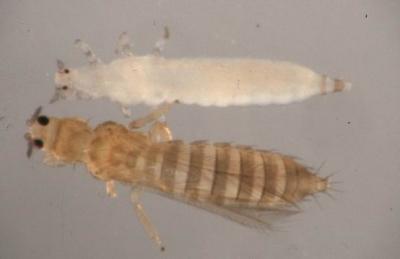

(Some species of Haplothrips are reported as pest in South Africa, we do not know if they are pests in Kenya or east Africa. Haplothrips are present in East Africa, but some of them are beneficial (predacious) and we do not know the status on the region. This will have to be reviewed when we finish with the datasheets). [br] When the status of Haplothrips in East Africa has been clarified we could decided if we leave this information on egg-laying habits. [br] Biological pesticides: check with list of Seif [br] FW: Include information on synthetic pesticides?
Thrips (Thrips tabaci and Frankliniella schultzei )
Thrips are small (1.5 mm long), slender, brown insects with pale yellow hind wings that appear as a yellow line down the back of the body when the insect is at rest. Adult thrips have characteristic wings; the transparent wings have a fringe of hairs around the outside edge standing out in the same plane as the wing.
The onion thrips (Thrips tabaci) and the blossom or cotton bud thrips (Frankliniella schultzei) are considered important pests of pineapples because they are vectors of the yellow spot virus, which have been shown to be identical to the tomato spotted wilt virus. The blossom thrips feeds mainly on flowers and its feeding results in the development of "dead-eye" in the fruit. Thrips feeding on the crown of fruits results in concentric ring patterns developing on crown leaves.
- Control weeds in and around pineapple plants as certain weeds leads to increased number of thrips.
- Control thrips in the early stages, in particular immature thrips; adult thrips are unable to pick the virus from infected plants. Once the immature thrips acquire infected with the virus they remain vectors for the rest of their lives.
- Conserve natural enemies. Thrips are attacked by predatory thrips, lacewings and predatory bugs. Avoid use of pesticides that kill natural enemies.
- Whenever necessary spot spray the crop with botanicals or other biopesticides. Some plant extracts (e.g. garlic, rotenone, neem, pyrethrum, and a mixture of garlic and pepper) are reported to control thrips. Spinosad, a bacterial derivative, is effective in controlling thrips. Liquid herbal manure and pyrethrum (in extreme situations) has also been recommended (Naturland, 2001). See also the section on yellow spot virus.
